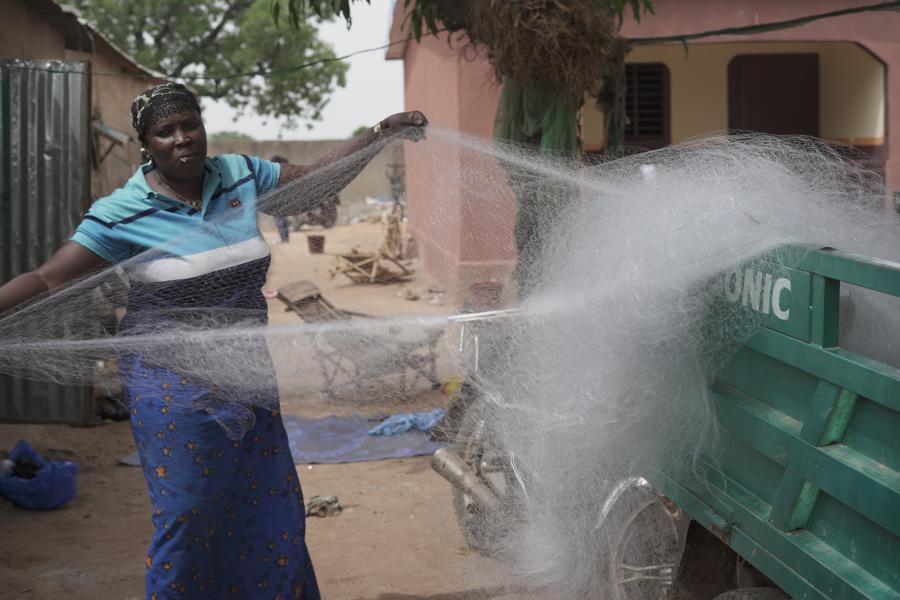Since 2012, armed conflict has escalated in the central Sahel, leading to a continuous increase in forced displacement. Currently, 2.8 million people are internally displaced across Burkina Faso, Mali, and Niger, countries which also host 411,190 refugees including those originating from the central Sahel.
In recent years the deterioration of the security and humanitarian situation in Burkina Faso has generated refugee movements towards Benin, Côte d’Ivoire, Ghana and Togo. The number of asylum seekers arriving in the northern regions of these four countries, rose to 87,000 at the start of 2024, of which 89% were from Burkina Faso, the majority, women and children.
The 2024 Gulf of Guinea Joint Response Plan led by WFP, UNICEF, UNHCR and IOM is a humanitarian response plan that interacts with existing development interventions in the northern regions of Benin, Côte d’Ivoire, Ghana and Togo. Its aim is to support national authorities to bridge the gap between humanitarian and development interventions by ensuring complementarity with development initiatives.
Download and read the 2024 Gulf of Guinea Joint Response Plan
For details about the various plans in the Gulf of Guinea countries, read and download the relative country chapters: Benin, Côte d’Ivoire, Ghana, Togo.
Populations
Population types
Note: The "Stateless" category does not include stateless people who are also in other categories, to avoid double counting. The total number of stateless, across all categories, is .
NB: 2025 figures are planning figures.
Source: UNHCR Refugee Data Finder for years until 2022, UNHCR planning figures (COMPASS) otherwise.
Population by country
NB: 2025 figures are planning figures.
Source: UNHCR Refugee Data Finder for years until 2022, UNHCR planning figures (COMPASS) otherwise.
Population by origin
NB: 2025 figures are planning figures.
Source: UNHCR Refugee Data Finder for years until 2022, UNHCR planning figures (COMPASS) otherwise.
Financials
Budget and expenditure trend
Budget information for the current year is updated monthly, while budget and expenditure information for all other years are final.
Budget by pillar
Budget by objective
Note: The table presents the budget for this operation broken down at the objective level. Resource allocation at the objective level is subject to change during the course of the year as the operational situation evolves and priorities shift. The current budget, reflected in the bottom line of this table, is updated on a monthly basis and is replaced by the final budget at year-end.
Expenditure by Outcome Area
Budget by Impact Area
Source: 2023 budget as approved by the Executive Committee in October 2022.
2022 current budget as approved by the High Commissioner as of October 2022; pending presentation to the ExCom's Standing Committee.
Budget by Outcome and Enabling Areas
Source: 2023 budget as approved by the Executive Committee in October 2022.
2022 current budget as approved by the High Commissioner as of October 2022; pending presentation to the ExCom's Standing Committee.
Budget by Impact Area
Source: 2024 budget and 2023 current budget are taken from the budget document approved by UNHCR's Executive Committee in October 2023.
Budget by Impact Area
Budget information for the current year is updated monthly, while budget and expenditure information for all other years are final.
Budget by Outcome and Enabling Areas
Budget by Outcome and Enabling Areas
Budget information for the current year is updated monthly, while budget and expenditure information for all other years are final.
Budget by Impact Area
Budget by Outcome and Enabling Areas
Strategy
Impact Statements
Latest updates
The boundaries and names shown and the designations used on this map do not imply official endorsement or acceptance by the United Nations.
UNHCR GIS data is publicly accessible in the Operational Data Portal






